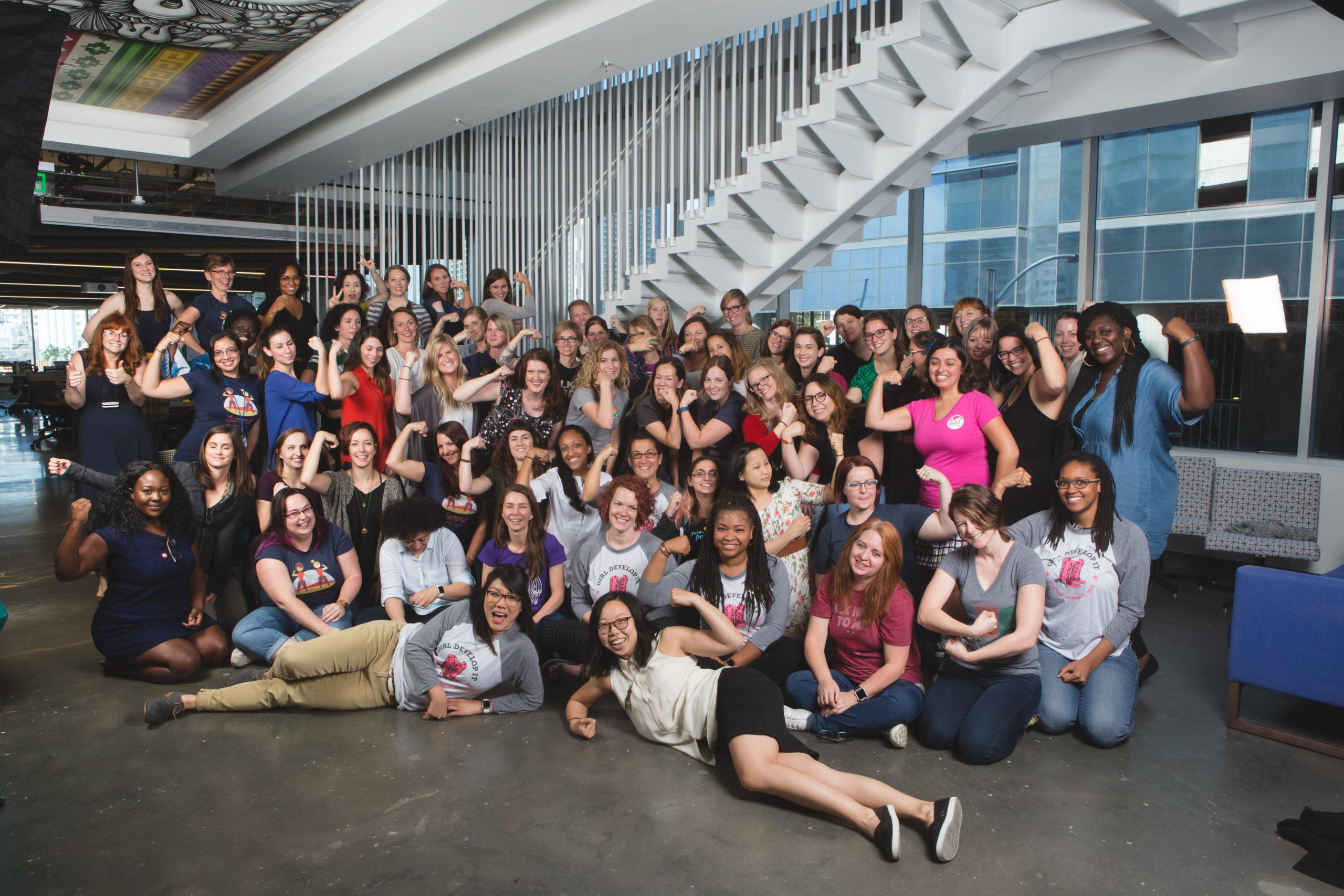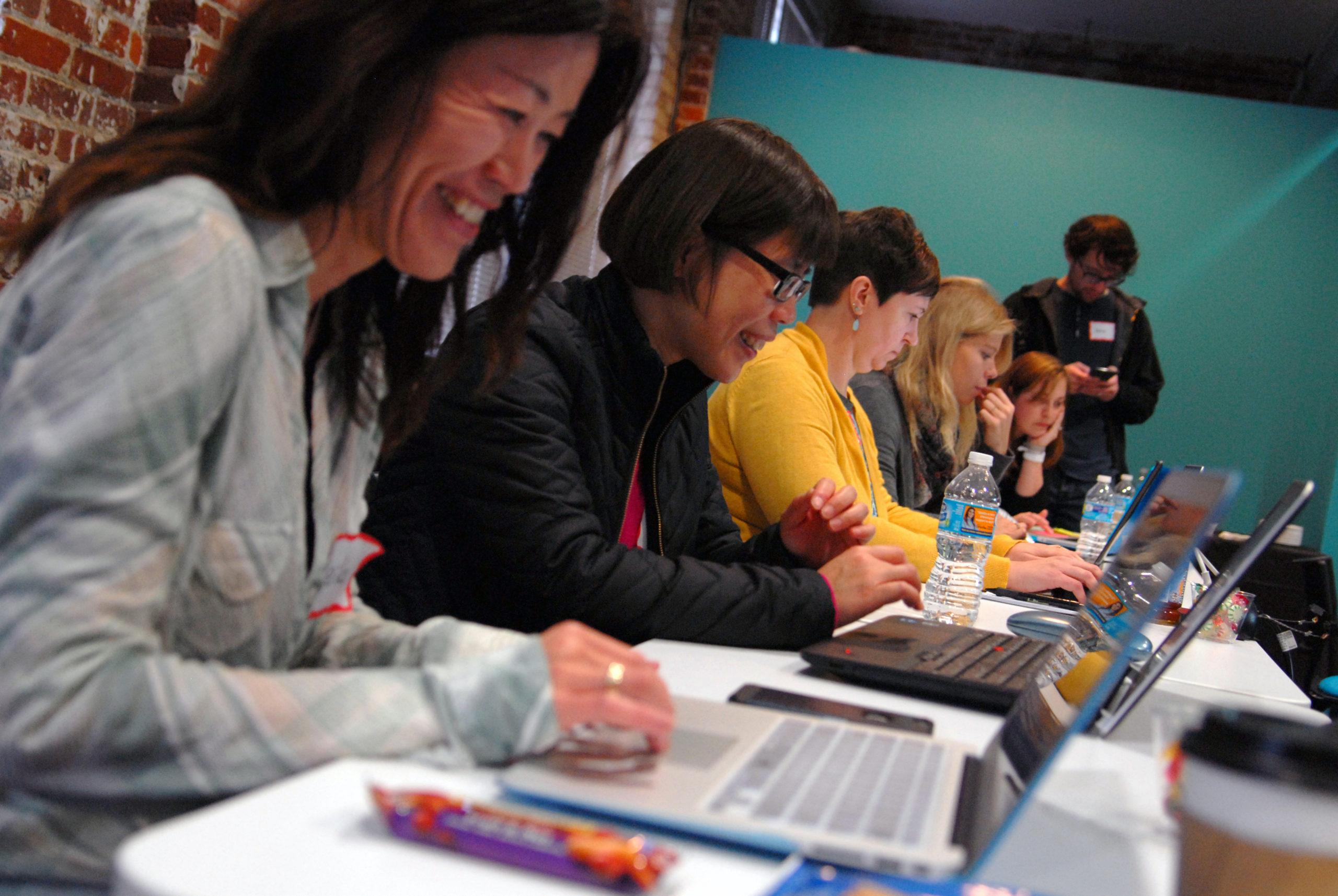By Krystin Gollihue
In 2010, New York City programmers Vanessa Hurst and Sara Chipps were asking themselves, “How can I help just one other woman learn to code?” The ongoing conversation about diversity and gender equity in the technology industry was prompting them to consider what it was that kept people from becoming tech professionals, and specifically, what they could do to help women break the barrier.
 That same year, Hurst and Chipps put together the first Girl Develop It (GDI) class on building technology skills, which sold out overnight. There were a few guiding principles: the class needed to provide an affordable, accessible, and judgement-free environment for adult women to learn web and software development. In 2016, Girl Develop It now has 72,000 national members, 54 chapters in cities across the country, and 183 women in chapter leadership positions. They serve everyone from the young mom trying to take control of her web design skills to the 65-year old grandmother who wants to understand what her grandchildren mean when they say, “blog”. At GDI, women are welcomed in with their own ideas of what a “beginner” is.
That same year, Hurst and Chipps put together the first Girl Develop It (GDI) class on building technology skills, which sold out overnight. There were a few guiding principles: the class needed to provide an affordable, accessible, and judgement-free environment for adult women to learn web and software development. In 2016, Girl Develop It now has 72,000 national members, 54 chapters in cities across the country, and 183 women in chapter leadership positions. They serve everyone from the young mom trying to take control of her web design skills to the 65-year old grandmother who wants to understand what her grandchildren mean when they say, “blog”. At GDI, women are welcomed in with their own ideas of what a “beginner” is.
 Classes are between 2 and 8 hours and are usually held on nights and weekends to accommodate full-time working professionals, mothers, or others who have stringent schedules. Instructors are current technology professionals, practitioners who develop their skills on a daily basis, and who can speak to the questions that students have about contemporary technologies. Instructors establish ground rules to create judgment-free zones: there are no stupid questions, and jargon is avoided so as to make sure that everyone understands concepts. Students are encouraged to mess up, make mistakes, and learn from those mistakes. In addition to instructors, classes include teaching assistants who guide students who may be too afraid to ask for help. The teaching assitant to student ratio in GDI classes is 5:1 so as to make sure that every student has someone to turn to with questions or guidance.
Classes are between 2 and 8 hours and are usually held on nights and weekends to accommodate full-time working professionals, mothers, or others who have stringent schedules. Instructors are current technology professionals, practitioners who develop their skills on a daily basis, and who can speak to the questions that students have about contemporary technologies. Instructors establish ground rules to create judgment-free zones: there are no stupid questions, and jargon is avoided so as to make sure that everyone understands concepts. Students are encouraged to mess up, make mistakes, and learn from those mistakes. In addition to instructors, classes include teaching assistants who guide students who may be too afraid to ask for help. The teaching assitant to student ratio in GDI classes is 5:1 so as to make sure that every student has someone to turn to with questions or guidance.
 Executive Director Corinne Warnshuis says that because women have historically been left out of technology, GDI aims to “invert that dominant ratio of men to women in technology. We want to make our students feel as if they’re in the company of peers who won’t judge them for what they don’t know.” While GDI mainly caters to women, all genders and identities are welcome.
Executive Director Corinne Warnshuis says that because women have historically been left out of technology, GDI aims to “invert that dominant ratio of men to women in technology. We want to make our students feel as if they’re in the company of peers who won’t judge them for what they don’t know.” While GDI mainly caters to women, all genders and identities are welcome.
GDI’s classes are some of the most affordable technology education courses anywhere in the country. Funds go towards paying instructors a stipend for their time, and any non-overhead leftover funds go towards scholarship money for women who may not be able to afford classes. Operationally, the reason classes are so affordable but still cost money is because GDI wants and needs to sustain themselves while at the same time paying women for the work they do as instructors. This principle is a big part of GDI’s overall ethos to support women at whatever the cost.
Success for Girl Develop It happens if a student attends a class and never comes back, but it also happens if a student attends a class and does come back to serve in a leadership position. Success means empowering women to understand how to run their own projects rather than outsource those decisions. Success is truly whatever a woman sets out to accomplish by taking classes with GDI. “Our mission is to be here for them, and we are aggressively mission-aligned,” says Warnshuis.
 Because 40% of their income comes from revenue, she adds, GDI is able to sustain themselves, pay women instructors for their work, and give women the opportunity to take classes for free. They’re able to stay true to their mission without the negative effects of mission-creep, which can sometimes happen if an organization becomes too reliant on outside funding. Whereas other organizations may have to adjust their goals to fit a grant’s objectives, GDI’s revenue stream allows them to be a true women’s empowerment organization. “We exist because women want us to be there; we’re not beholden to grants or foundation, so we’re able to truly work for the people we serve.”
Because 40% of their income comes from revenue, she adds, GDI is able to sustain themselves, pay women instructors for their work, and give women the opportunity to take classes for free. They’re able to stay true to their mission without the negative effects of mission-creep, which can sometimes happen if an organization becomes too reliant on outside funding. Whereas other organizations may have to adjust their goals to fit a grant’s objectives, GDI’s revenue stream allows them to be a true women’s empowerment organization. “We exist because women want us to be there; we’re not beholden to grants or foundation, so we’re able to truly work for the people we serve.”
One of the struggles that GDI has is when people want to partner in order to have access to their students or community for hiring purposes. “That’s not necessarily always going to be in line with what we do,” Warnshuis says. While the issue of gender equity in technology is important, Girl Develop It does not do what it does in order to serve the technology industry. “We provide opportunities to women. We don’t provide women to companies in order to solve an issue that the companies aren’t working on themselves.  It’s a nice side effect when women do want to go into technology and we can make those things happen organically from within our community, but we’re never going to say that we will accept $1 million to change our focus to that.”
It’s a nice side effect when women do want to go into technology and we can make those things happen organically from within our community, but we’re never going to say that we will accept $1 million to change our focus to that.”
Warnshuis’s advice to organizations that struggle with staying true to their mission is to reconsider what a mission statement is in the first place. “It’s not just a statement that lives on your website, or even a statement that exists to tell people what you do. It’s really a road map, and everything that falls outside of it is not on the map.”
Above all else, Girl Develop It is about building a community for women. “We are so much stronger because we’ve done this together,” Warnshuis notes. “We share this knowledge among this huge community of willing-to-learn women. We’ve learned so much from our chapters and from one another that’s made our mission, and our organization, so much stronger.”





